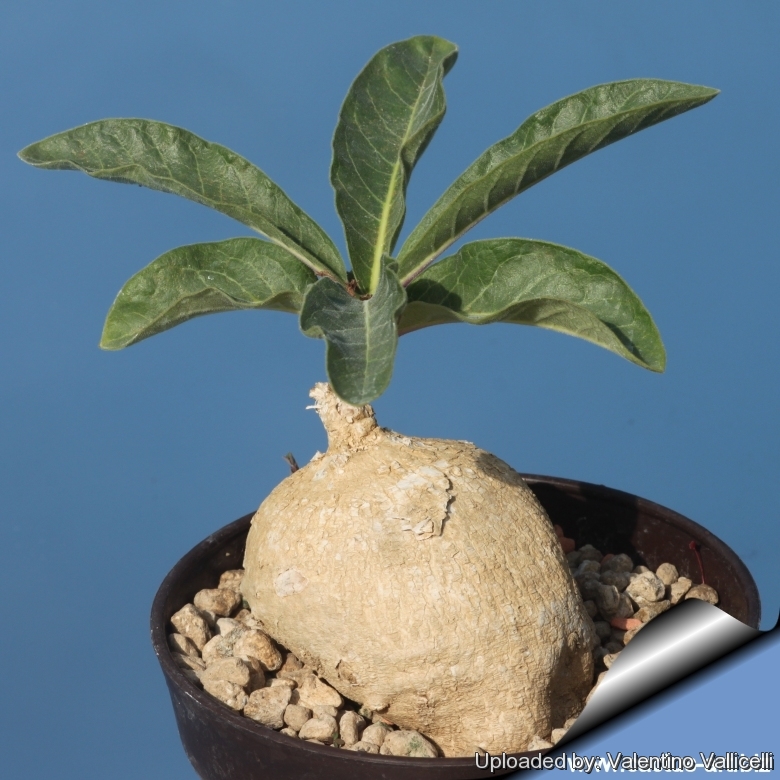Accepted Scientific Name: Raphionacme madiensis S.Moore
J. Bot. 46: 293. 1908

Raphionacme wilczekiana Photo by: Valentino Vallicelli
Origin and Habitat: Angola, Burundi, DRC, Rwanda, Uganda, Kenya, Tanzania, Zimbabwe.
Altitude: 500-1500 metres above sea level.
Habitat:It grows in grassy clearings in open Acacia or mopane woodland in sub- arid to subhumid regions on laterite soil on mountain slopes often in community with Vellozia, Cyphia and Monadenium.
Synonyms:
See all synonyms of Raphionacme madiensis
Description: Raphionacme madiensisSN|23942]]SN|23941]] is short stemmed species with attractive green and purple flowers.
Habit: It is a perennial geophyte, with a swollen caudiciform base.
Caudex (tuber): Subspherical, more or less woody, up to 20 cm high and 16 cm in diameter.
Branches: One to several, herbaceous, annual, erect to spreading, somewhat roughly hairy with abundant milky sap, about 5-40 cm tall (more often 10-15 cm tall) from the woody neck of the tuber.
Leaves: Simple arranged alternately along the stems, sessile or short petiolate, more or less narrowly ovate-elliptic, ovate or obovate, basally tapering, 7-14 cm long, green above, paler below, finely velvety with denser indumentum on the much paler veins, wrinkled; margin entire and wavy; petiole 5-20 mm long.
Inflorescences: Small terminal and axillary cymes, 5-10-flowered.and more or less roughly hairy.
Flowers: Corolla bell-shaped more than 7 mm long; lobes spreading, oblong-ovate to oblong-triangular, 5-7 mm long, whitish or greenish with brown, pink, magenta or violet streaks, tips or margins. Corona lobes apically 3-segmented; central segment 5-7 mm long, linear to filiform; lateral segments 2-3 mm long, hairless or papillose.
Fruits: Produces a distinctive very thick solitary follicle, ovoid to cuneate 4,5-6 cm long. (very thick fruits are also known from Raphionacme namibiana and Raphionacme wilczekianaSN|23941]]SN|23942]])
Cultivation and Propagation: Raphionacme madiensisSN|23941]]SN|23941]] is caudiciform plant that grows well in container.
Soil: Give the plant a well drained, airy but rich growing medium which consists of non organic material such us clay, pumice, lava grit, and peat or leaf-mould.
Irrigation: It is probably a summer grower species and need a good deal of water during active growth from spring when the new leaves can be seen forming from the woody neck of the tuber and should be watered only when not dormant. In autumn the leaves begin to go yellow and drop off, so now it rests quite dry in to winter. No water should ever be allowed to stand around the roots. An error in cultivation may produce unsightly holes in the tuber.
Exposure: In cultivation the plants are usually grown in semi shade, with the tubers wholly or (preferably) partially exposed to prevent scorching and rotting of the roots.
Hardiness: It should be overwintered in the greenhouse at temperatures over 12°C (avoid letting temperatures drop lower than 5° C, but some authors suggest that it can withstand light frost down to -7º C at least for short periods if very dry, in these situations it will better resist if sheltered by the winter rains, seen that the humidity and low temperatures render it more sensitive to rottenness. Plants in containers however, suffered major leaf loss.
Maintenance: The dried annual stems need to be removed to keep a tidy appearance. Like quite small pots, repot in very later winter, early spring.
Reproduction: Can be reproduced both by cuttings and seeds.










